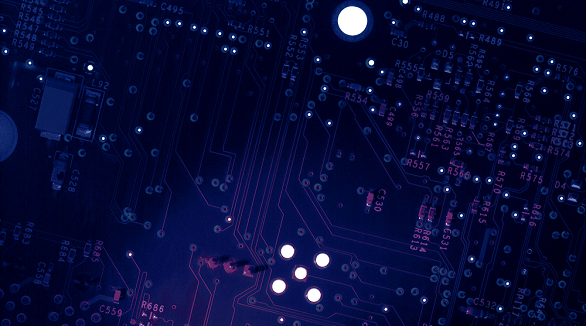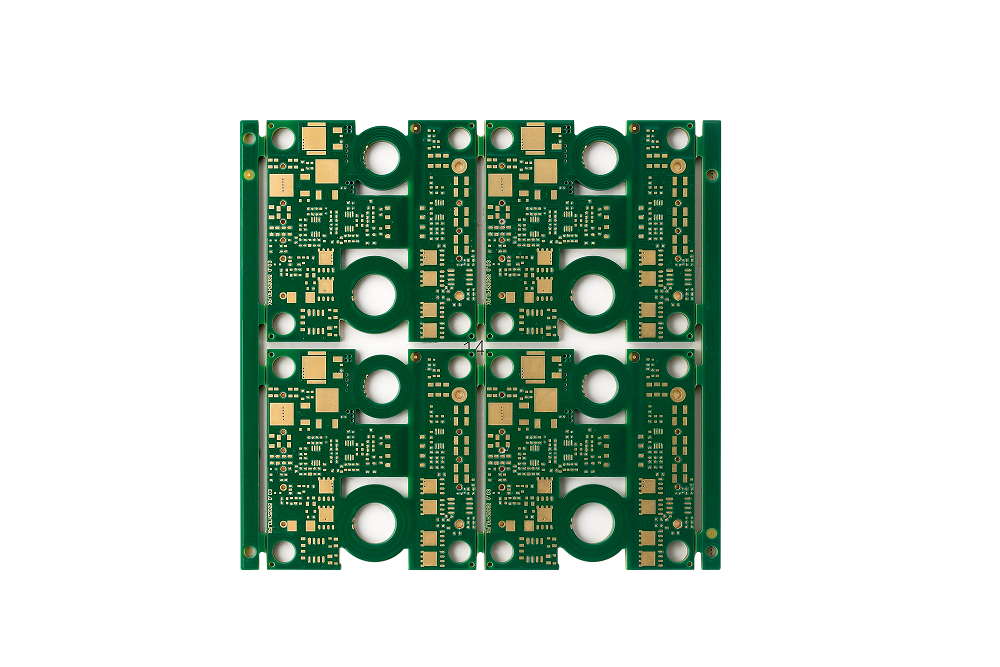
PCB Introduction & Types
Most electronic circuits are mounted on PCBs, or Printed Circuit Boards, which provide mechanical support and electrical interconnection of electronic components. There are, however, special applications that involve the use of single and double-sided PCBs, multi-layer PCBs, or even rigid and flexible PCBs with aluminum backing, targeting medical, industrial, auto, and aerospace industries. They may use materials such as fiberglass, epoxy, aluminum, and others.
What is a PCB?
PCB (Printed Circuit Board ) is used as a base in most electronics, both as a physical support piece and as the area for wiring for the surface-mounted and socketed components. Most are made from fiberglass, composite epoxy, or other composite material.
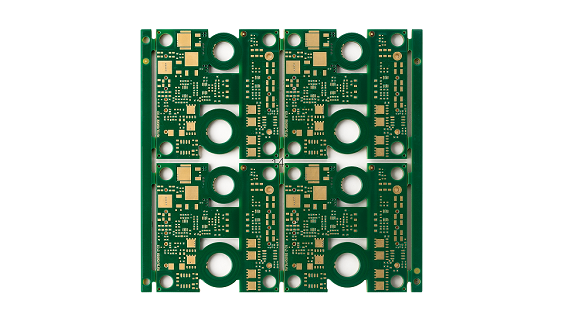
The majority of PCBs used to construct simple circuits have a straightforward design with only one layer. More advanced technology, such as computer graphics cards or motherboards, might include several layers—up to twelve in some cases.
Although PCBs are most commonly linked with computers, they can also be found in televisions, radios, digital cameras, and cell phones. Different types of PCB are used in:
• Medical devices: Considering the density of electronic products and low power consumption compared to previous generations, testing new exciting medical technology is within reach. Most medical devices use high-density PCBs to create the tiniest and densest design, which relieves some of the unique constrictions involved in developing devices for the medical field. The concept of the PCB has fallen its way onto just about everything from small devices, like pacemakers, to much larger devices like X-ray equipment or even CAT scanning machines.
• Industrial machinery: Since PCB is widely utilized in high-powered machinery, a thick copper PCB can be used where current one-ounce copper PCB does not fit the requirements, so thicker copper PCBs should be used include motor controllers, high-current battery chargers, and industrial load testers.
• Lighting: With the growing popularity of LED-based lighting solutions due to its low power consumption and high levels of efficiency, aluminum-backed PCB is also seeing an increase in usage as a material used in the creation of the aforementioned lighting solution. These PCBs frequently serve as heat sinks, allowing for higher degrees of heat transmission than a normal PCB. The same aluminum-backed PCBs are used to create both high-lumen LED applications and basic lighting solutions.
• Automotive and aerospace industries: Flexible PCBs are used in both the automobile and aerospace industries, both of which have severe vibration levels. Furthermore, they can be extremely lightweight while conforming to requirements and design, which is essential when making parts for the transportation industry. They can also fit into tiny locations like inside instrument panels or behind dashboard gauges.
There are various sorts of printed circuit boards, each with its own set of manufacturing criteria, material types, and applications. They include the following:
Single-layer PCB

A single-layer or single-sided PCB has a single layer of base material or substrate, with one side covered in a thin layer of metal. Copper is the most prevalent because of its superior electrical conductivity. In most situations, a protective solder mask is added following the copper base plating, and the final silkscreen is used to map out all of the board's parts.
Single-layer/single-sided PCBs are easy to design and manufacture since diverse circuitry and components are connected onto one side, which means that they can be obtained at a low cost, especially for high-volume orders. Because of their low-cost, high-volume model, they are frequently used in calculators, cameras, radios, stereo equipment, solid-state drives, printers, and power supplies.
Double-layer PCB
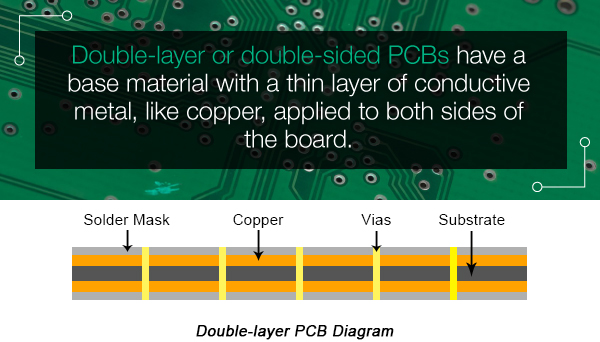
Double-layer or double-sided PCB has a thin layer of conductive metal, like copper, applied to both sides of a base material. Holes drilled through the board connect circuits on one side to those on the other.
The circuits and components of a double-layer PCB are usually connected in two ways: either using a through-hole or a surface mount. Through-hole connections simply imply that small wires are fed through the holes, with each end of the lead connected to the right component.
One of the biggest differences between surface-mount and through-hole PCBs is that the former do not use wire as connectors, while many small leads are soldered directly onto the board, which is used as a wiring surface for the different components, which facilitates circuits to be completed using less space but frees up space to allow the board to complete more functions with higher speeds and lighter weight than a through-hole board would allow.
Double-sided PCBs is normally used for applications that require an intermediate level of circuit complexity, ranging from industrial controls and power supplies to instrumentation, HVAC, LED lighting systems, automotive dashboards, amplifiers, and vending machines.
Multi-layer PCB

A multi-layer PCB consists of a series of three or more double-layered PCBs, attached by using a type of adhesive and sandwiched between pieces of insulation to make sure that no extra heat melts any of the components. Multi-layer PCBs can be gotten in different sizes—from as small as four to large ten- and twelve-layered. The largest multi-layer PCB ever built was one at 50 layers thick. Applications where multi-layer PCBs would come in handy include file servers, data storage, GPS technology, satellite systems, weather analysis, and medical equipment.
Rigid PCB
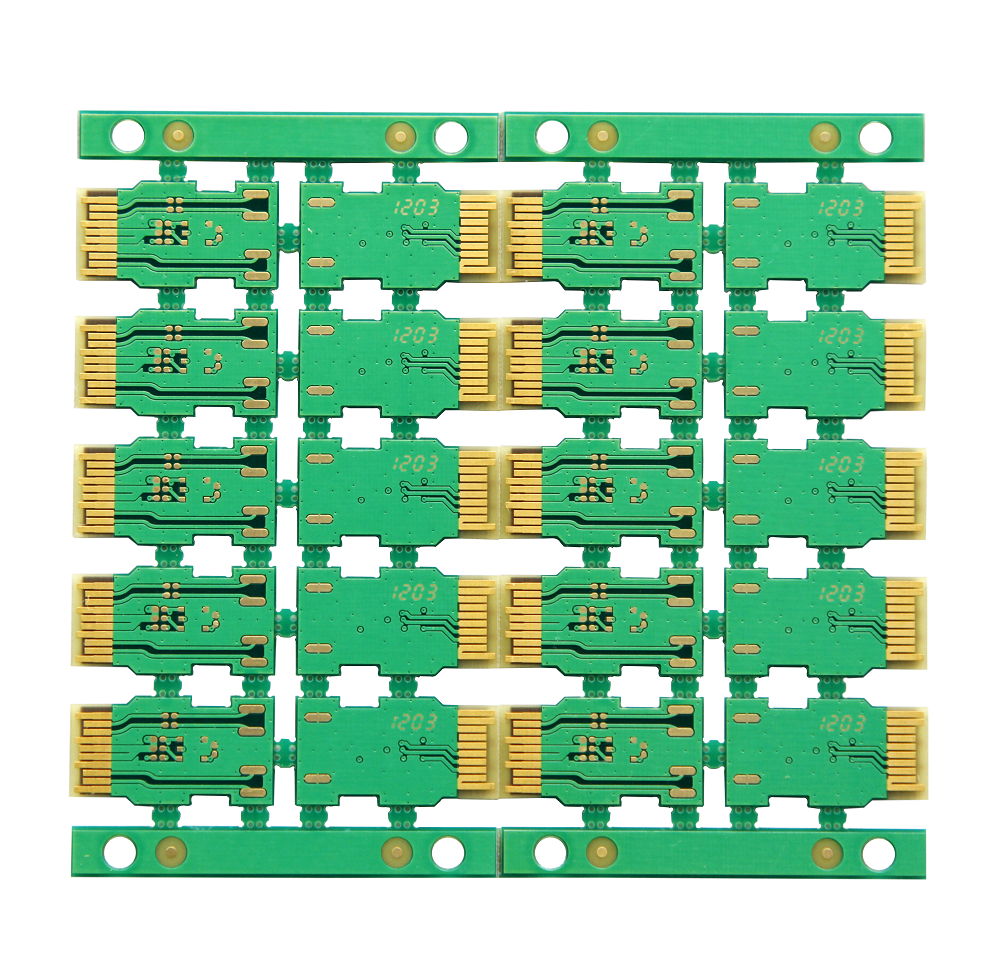
Rigid PCB is made of a solid substrate that prevents the board from twisting, the most common example of which is the computer motherboard. It is a multilayer PCB designed to share electricity from the power supply while allowing communication between all of the many parts of the computer at the same time, such as the CPU, GPU, and RAM.
Rigid PCB may be the largest number of produced PCB, used anywhere where there is a need for the PCB itself, which has to be set up in shape remaining for the rest of the life of the device. From a simple single-layer PCB to an eight- or ten-layer multi-layer PCB, all of them belong to rigid PCB; hence, they could all find applications in the same area.
Flexible PCB
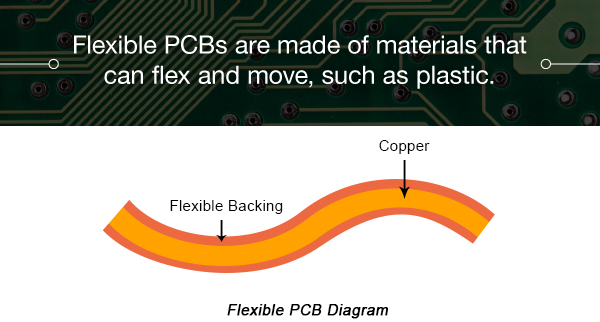
Unlike rigid PCB using unmoving materials like fiberglass, flexible PCB consists of materials that bend and move, normally plastic. Similar to rigid PCBs, flexible PCBs are also available in single, double- or multi-layer formats since they have to be printed on a flexible material. The fabrication of flexible PCBs costs more.
Nevertheless, flexible PCBs still have many advantages over rigid PCBs. The most prominent of these advantages is that they are flexible; that is, they may be folded over edges and wrapped around corners. Their flexibility can lead to weight and cost savings since a single flexible PCB can cover areas that might take multiple rigid PCBs.
The flexible PCBs can also be used in areas subject to environmental hazards. They are simply built using waterproof, shockproof, corrosion-resistant, or high-temperature oil-resistant materials to do so—an option that traditional rigid PCBs may not have.
Flexible PCBs are also suitable for usage in hazardous environments. They are simply made with waterproof, shockproof, corrosion-resistant, or high-temperature oil-resistant materials — the feature that typical rigid PCBs may lack.
Rigid-Flex PCB
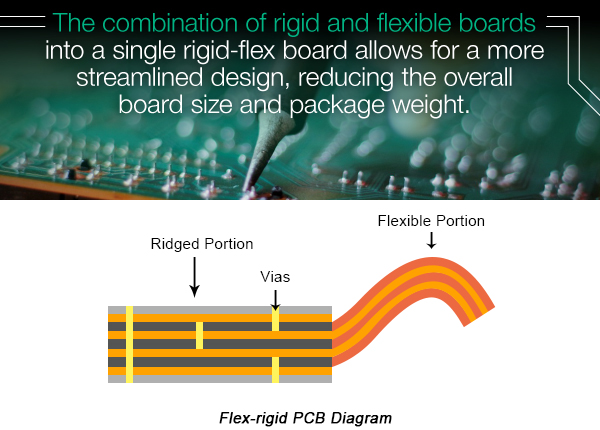
Rigid flex circuits combine the advantages of the two most important forms of PCB boards, made up of many layers of flexible PCBs connected together with rigid PCB layers.
Flex-rigid PCBs have several advantages over rigid PCBs and flexible PCBs for custom applications. For example, rigid-flex boards have fewer pieces than standard rigid or flexible PCB since the wiring possibilities for both are merged onto a single board. The rigid-flex board also provides for a more streamlined design, reducing overall board size and packaging weight by integrating the hard and flexible boards.
Flex-rigid PCBs have most of their applications where the space or weight of a device is the prime concern, such as cell phones, digital cameras, pacemakers, and even automobiles.
High-frequency PCB

High-frequency PCB refers to the general element of a PCB design, not like the preceding models which refer to the kind of construction, while meant to transmit signals over one gigahertz.
High-frequency PCB materials generally include FR4-grade glass-reinforced epoxy laminate, polyphenylene oxide resin, and Teflon. Teflon comes at a rather high price because of its small and stable dielectric constant, small dielectric loss, and generally low water absorption.
In choosing a high-frequency PCB board and its corresponding type of PCB connector, many aspects should be taken into consideration, including dielectric constant, dissipation, loss, and dielectric thickness.
The most essential of these is the Dk of the material under consideration. Changes in impedance are common in materials with a high possibility of changing their dielectric constant, which can modulate the harmonics that make up a digital signal and cause an overall loss of digital signal integrity, which is one of the things that a high-frequency PCB is designed to prevent.
The following boards and PC connector types should be considered for the high-frequency PCB design:
• Dielectric loss, DF; responsible for the quality of the signal to be conveyed; a small amount of dielectric loss may result in a small amount of signal wasted.
• Thermal expansion. If the rates of thermal expansion of the PCB's construction elements, such as copper foil, differ, materials may separate owing to temperature fluctuations.
• Water absorption. High water intake will have an impact on the dielectric constant and dielectric loss of the PCB, particularly if it is utilized in damp conditions.
• Other resistances. Wherever possible, construction materials for high-frequency PCBs should have excellent heat resistance, stress endurance, and resistance to hazardous chemicals ratings.
Aluminum-Backed PCB

Aluminum-backed PCBs are designed in much the same way as their copper-backed counterparts. However, instead of the usual fiberglass used in most of the PCB board types available, aluminum-backed PCB makes use of aluminum or copper substrate boards.
The aluminum-backed PCB is lined with thermally insulating material that has low thermal resistance, thus less heat is transferred from the insulating layer to the backing. A copper circuit layer, ranging in thickness from one ounce to 10, is deposited using insulation material.
Aluminum-backed printed circuit boards have some advantages over those with a fiberglass backing, including:
• Low cost. Aluminum is the most abundant metal on Earth, making up 8.23% of the weight of the planet. It's easy and inexpensive to mine aluminum from the ground; therefore, these reduce expenses in the manufacturing process. As such, constructing products made of aluminum will be cheaper.
• Eco–friendly: Aluminum itself is non-toxic and easily recyclable. Further, the manufacturing of a PCB with aluminum doesn't involve too much energy consumption in comparison to its other counterparts because of the nature of its ease of assembly.
• Heat dissipation: This is because aluminum is among the best materials at dissipating heat away from critical components on circuit boards, draining the heat to the open air without diffusing it into others towards the board. Most importantly, an aluminum PCB will therefore cool more quickly than a copper PCB of the same size.
• Material durability: Aluminum is far stronger than other materials, like fiberglass or ceramic, particularly in drop tests. Using stronger base materials reduces potential damage during manufacture, shipping, and installation.
All these advantages make Aluminum PCB an outstanding choice for applications that require high outputs of power within very tight tolerances, such as traffic lights, automotive lighting, switching power supplies, motor controllers, and high-current circuitry.
Besides these major areas of application, aluminum-backed PCBs can also be used in applications where a high degree of mechanical stability is required or where the PCB might be subject to high levels of mechanical stress. They are less subject to thermal expansion compared with a fiberglass-based board and, therefore, peeling off the other materials on the board, such as copper foil or insulation, is avoided, thus further lengthening its lifetime.
From simple single-layer PCBs applied in simple electronics like calculators to more complex systems—like high-frequency Teflon design—PCBs have undergone evolution over the years. This has made its way into nearly every industry currently running on the face of the earth, from simple industries like lighting solutions to more complex ones like medical or aerospace technology.
Long years of PCB evolution have also pushed development in materials: no longer are PCBs built solely out of fiberglass-backed copper foil. New construction materials include aluminum, Teflon, and even bendable plastics, especially bendable plastics and aluminum, especially, spurring the creation of products like flexible-rigid and aluminum-backed PCBs to address common problems associated with many industries.
Trust PCBX for All Your PCB Production Needs
Whether you need a simple single-layer PCB or a highly sophisticated 30-layer multi-layer PCB, PCBX can help you realize your goal. We can provide fabrication services for a wide range of PCBs, from basic fiberglass to flex-rigid PCBs. Special applications can also benefit from high-frequency PCBs and aluminum-backed PCBs.
Want to get the price of specialty PCB fabrication like Flexible PCBs, Flex-rigid PCBs, Aluminum PCBs, Rogers PCBs, etc.? Feel free to contact us and send your Gerber file and requirements for materials and quantity, and we will provide a quote soon.
We also offer prototype circuit boards to help you get the right PCB design before full production. Avoiding costly errors can save you thousands over the scope of the project. Our designers are compliant with ISO9001:2008 quality management systems, and our in-house quality control department will verify your prototype to both of our high standards before we send it off to you. Depending on requirements, most prototype PCBs can be done within 4-5 days when you need quality prototyping done fast.
We directly provide assembly services once your PCB is fabricated and prototyped. We do all from prototype, consigned PCB assembly, full or turnkey PCB assembly, and partial or full assembly based on customer-specified requirements. We cater to several quantity demands, from low-volume/high-mix assemblies to high-volume PCB assemblies. All our turnkey services are IPC Class 3 compliant, and ISO 9001:2008-certified.
PCBX handles simple, average, or complicated mixed assembly items that are fundamental to PCB design, such as surface mountings and through-hole connections. Part of our quality control involves extending a design for a manufacturability test. We can also do particular function testing depending on your needs to ensure that the PCBs we manufacture meet the design standards from which they were generated.
Hot Tags:
Contact us

If you can't find what you're looking for, please contact us.

